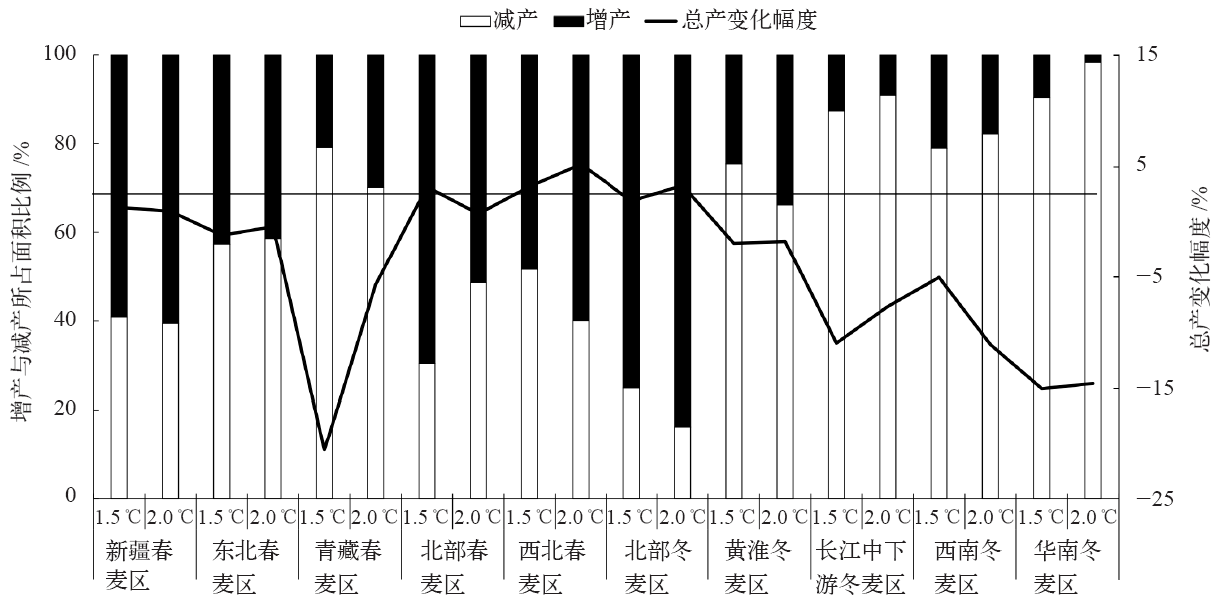Climate Change Research ›› 2018, Vol. 14 ›› Issue (6): 573-582.doi: 10.12006/j.issn.1673-1719.2018.090
• Impacts of Climate Change • Previous Articles Next Articles
The impact of 1.5℃and 2.0℃global warming on wheat production in China
Ru SUN1,Xue HAN1,Jie PAN1,Wei XIONG1,2,Hui JU1
- 1 Institute of Environment and Sustainable Development in Agriculture, Chinese Academy of Agricultural Sciences, Beijing 100081, China
-
Received:2018-06-14Revised:2018-07-24Online:2018-11-30Published:2018-11-30 -
Contact:Xue HAN
Cite this article
Ru SUN,Xue HAN,Jie PAN,Wei XIONG,Hui JU. The impact of 1.5℃and 2.0℃global warming on wheat production in China[J]. Climate Change Research, 2018, 14(6): 573-582.
share this article
Add to citation manager EndNote|Ris|BibTeX
URL: http://www.climatechange.cn/EN/10.12006/j.issn.1673-1719.2018.090
|
| [1] | XU Li,LI Qian,WANG Ying,HUANG Jing-Ling,XU Ying-Jun. Analysis of the changes in debris flow hazard in the context of climate change [J]. Climate Change Research, 2020, 16(4): 415-423. |
| [2] | CHEN Xi,LI Ning,ZHANG Zheng-Tao,LIU Jia-Wei,WANG Fang. Estimation of future global population exposure to heatwaves—based on the heat stress index [J]. Climate Change Research, 2020, 16(4): 424-432. |
| [3] | DING Kai-Xi,ZHANG Li-Ping,SHE Dun-Xian,ZHANG Qin,XIANG Jun-Wen. Variation of extreme precipitation in Lancang River basin under global warming of 1.5℃ and 2.0℃ [J]. Climate Change Research, 2020, 16(4): 466-479. |
| [4] | LI Rou-Ke,HAN Zhen-Yu,XU Ying,SHI Ying,WU Jia. An ensemble projection of GDP and population exposure to high temperature events over Jing-Jin-Ji district based on high resolution combined dynamical and statistical downscaling datasets [J]. Climate Change Research, 2020, 16(4): 491-504. |
| [5] | Hao-Jun SHEN, Yong LUO, Zong-Ci ZHAO, Han-Jie WANG. Prediction of summer precipitation in China based on LSTM network [J]. Climate Change Research, 2020, 16(3): 263-275. |
| [6] | Qi-Mou ZHANG,Run WANG,Tong JIANG,Song-Sheng CHEN. Projection of extreme precipitation in the Hanjiang River basin under different RCP scenarios [J]. Climate Change Research, 2020, 16(3): 276-286. |
| [7] | Ying-Xue LUO,Chang-Chun XU,Zhi CHU,Qi SUN,Li CHEN. Application of CN05.1 meteorological data in watershed hydrological simulation: a case study in the upper reaches of Kaidu River basin [J]. Climate Change Research, 2020, 16(3): 287-295. |
| [8] | Jia-Le ZHANG,Zhi-Hua PAN,Wen-Hui KUANG,Yu-Ying PAN,Guo-Lin HAN,Jia-Lin WANG,Na HUANG,Zi-Yuan ZHANG,Wen-Juan YIN. Spatial-temporal change features of impervious surface and its effect on land surface temperature from 1984 to 2014 in Beijing [J]. Climate Change Research, 2020, 16(3): 296-305. |
| [9] | Ke WANG,Tao PU,Xiao-Yi SHI,Yan-Long KONG. Impact of temperature and precipitation on runoff change in the source region of Lancang River [J]. Climate Change Research, 2020, 16(3): 306-315. |
| [10] | LIU Chong,ZHAO Ping. Climatological characteristics of Sichuan Basin vortex during 1979-2016 [J]. Climate Change Research, 2020, 16(2): 203-214. |
| [11] | Dai WANG,Yin-Chuan SUN,Qing-Long YOU. Contribution of Pacific Decadal Oscillation to interdecadal variability of winter minimum temperature in China [J]. Climate Change Research, 2020, 16(1): 70-77. |
| [12] | Jing-Fu CAO,Ming-Cai LI,Mei-Ling SUN,Yue-Hao CHEN,Yan-Juan YANG,Rui-Xue ZHANG. Applicability of cooling degree-days based on wet bulb temperature as an index of cooling energy consumption [J]. Climate Change Research, 2019, 15(6): 617-623. |
| [13] | Yun-Jian ZHAN,Guo-Yu REN,Peng-Ling WANG. The influence of data processing on constructing regional average precipitation time series [J]. Climate Change Research, 2019, 15(6): 584-595. |
| [14] | Hong YIN,Ying SUN. Characteristics of extreme temperature and precipitation in China in 2017 based on ETCCDI indices [J]. Climate Change Research, 2019, 15(4): 363-373. |
| [15] | Yao-Ming LIAO,Deliang CHEN,Qiu-Feng LIU. The spatiotemporal characteristics and long-term trends of surface-air temperatures difference in China [J]. Climate Change Research, 2019, 15(4): 374-384. |
| Viewed | ||||||
|
Full text |
|
|||||
|
Abstract |
|
|||||










